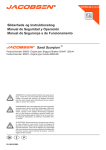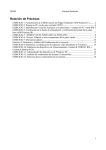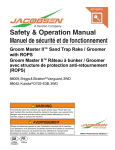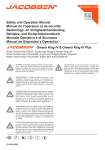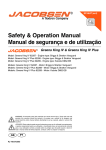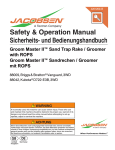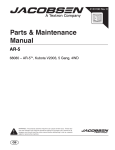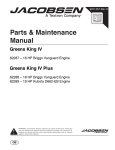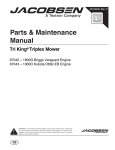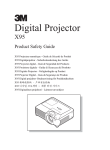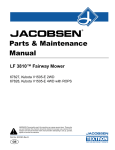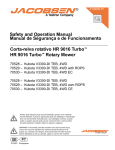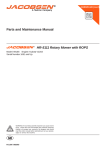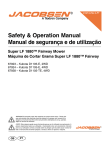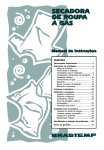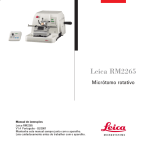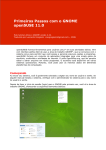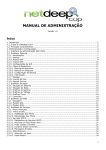Download warning - Jacobsen
Transcript
4130277-PT 6DIHW\2SHUDWLRQ0DQXDO 0DQXDOGH6HJXUDQoDHGR2SHUDGRU *URRP0DVWHU,, Sand Trap Rake Ancinho para Recolha de Areia 88008, Kubota D662-E, 3WD 88009, Briggs & Stratton Vanguard, 3WD Modelo 88009 - Motor Kubota D662-EB, 3 Rodas Motrizes Modelo 88008 - Motor Briggs Vanguard, 3 Rodas Motrizes WARNING:If incorrectly used, this machine can cause severe injury. Those who use and maintain this machine should be trained in its proper use, warned of its dangers and should read the entire manual before attempting to set up, operate, adjust or service the machine. FORWORD This manual contains Safety and Operating instructions for your new Jacobsen machine. A Parts & Maintenance Manual has also been included that contains adjustment, maintenance, troubleshooting instructions and parts list. Both manuals should be stored in the literature pouch behind the seat for reference during operation. The mower serial plate is located on the seat pan, to the left of the seat. Jacobsen recommends you record these numbers below for easy reference. ® Before you operate your machine, you and each operator you employ should read both manuals carefully in their entirety. By following the safety, operating and maintenance instructions, you will prolong the life of your mower and maintain its maximum efficiency. A Textron Company CHARLOTTE, NC MADE IN U.S.A. 88008 If additional information is needed, contact your Jacobsen Dealer. 1 CONTENTS 1 1 2 2.1 2.2 3 3.1 4 4.1 4.2 5 5.1 5.2 5.3 CONTENTS CONTENTS SAFETY Operating Safety .................................................. 3 Important Safety Notes ........................................ 4 DECALS Decals.................................................................. 5 INITIAL INSPECTION General ................................................................ 7 Initial Inspection ................................................... 7 CONTROLS Icons .................................................................... 8 Control Descriptions .......................................... 10 Operator Alerts .................................................. 11 6 6.1 6.2 6.3 6.4 6.5 6.6 6.7 6.8 6.9 6.11 6.12 7 OPERATION Daily Inspection ................................................. 12 Interlock System ................................................ 12 Operating Procedures ....................................... 13 Starting .............................................................. 14 Stopping / Parking ............................................. 14 To Drive / Transport ........................................... 15 Hillside Operation .............................................. 15 Attachments ....................................................... 15 Towing / Trailering ............................................. 16 Daily maintenance ............................................. 17 Long Term Storage ............................................ 18 NOTES Proposition 65 Warning Engine exhaust from this product contains chemicals known to the State of California to cause cancer, birth defects, and other reproductive harm © COPYRIGHT 2004, TEXTRON INC. “All rights reserved, including the right to reproduce this book or portions thereof in any form”. All information in this publication is based on information available at time of approval for printing. Jacobsen reserves the right to make changes at any time without notice and without incurring any obligation. GB-2 LITHO IN U.S.A. 9-2004 SAFETY 2 2.1 2 SAFETY OPERATING SAFETY ______________________________________________________ ! WARNING EQUIPMENT OPERATED IMPROPERLY OR BY UNTRAINED PERSONNEL CAN BE DANGEROUS. Familiarize yourself with the location and proper use of all controls. Inexperienced operator’s should receive instruction from someone familiar with the equipment before being allowed to operate the machine. 1. Safety is dependent upon the awareness, concern and prudence of those who operate or service the equipment. Never allow minors to operate any equipment. 2. It is your responsibility to read this manual and all publications associated with this equipment (Safety and operation manual, engine manual, accessories and attachments). If the operator can not read English it is the owner’s responsibility to explain the material contained in this manual to them. 3. 4. Learn the proper use of the machine, the location and purpose of all the controls and gauges before you operate the equipment. Working with unfamiliar equipment can lead to accidents. Never allow anyone to operate or service the machine or its attachments without proper training and instructions; or while under the influence of alcohol or drugs. 5. Wear all the necessary protective clothing and personal safety devices to protect your head, eyes, ears hands and feet. Operate the machine only in daylight or in good artificial light. 6. Evaluate the terrain to determine what accessories and attachments are needed to properly and safely perform the job. Only use accessories and attachments approved by Jacobsen. 7. Stay alert for holes in the terrain and other hidden hazards. 8. 9. Inspect the area where the equipment will be used. Pick up all the debris you can find before operating. Beware of overhead obstructions (low tree limbs, electrical wires, etc.) and also underground obstacles (sprinklers, pipes, tree roots, etc.) Enter a new area cautiously. Stay alert for hidden hazards. Never direct discharge of material toward bystanders, nor allow anyone near the machine while in operation. The owner/operator can prevent and is responsible for injuries inflicted to themselves, to bystanders and damage to property. 10. Do not carry passengers. Keep bystanders and pets a safe distance away. 11. Never operate equipment that is not in perfect working order or is without decals, guards, shields, discharge deflectors or other protective devices securely fastened in place. 12. Never disconnect or bypass any switch. 13. Do not change the engine governor setting or overspeed the engine 14. Carbon monoxide in the exhaust fumes can be fatal when inhaled. Never operate the engine without proper ventilation or in an enclosed area. 15. Fuel is highly flammable, handle with care. 16. Keep the engine clean. Allow the engine to cool before storing and always remove the ignition key. 17. Disengage all drives and engage parking brake before starting the engine (motor). Start the engine only when sitting in operator’s seat, never while standing beside the unit. 18. Equipment must comply with the latest federal, state, and local requirements when driven or transported on public roads. Watch out for traffic when crossing or operating on or near roads. 19. Local regulations may restrict the age of the operator. 20. Never use your hands to search for oil leaks. Hydraulic fluid under pressure can penetrate the skin and cause serious injury. 21. Operate the machine up and down the face of the slopes (vertically), not across the face (horizontally). 22. To prevent tipping or loss of control, do not start or stop suddenly on slopes. Reduce speed when making sharp turns. Use caution when changing directions. 23. Keep legs, arms and body inside the seating compartment while the vehicle is in motion. This machine is to be operated and maintained as specified in this manual. It is intended for professional use and is equipped with attachments designed to move, smooth and loosen sandy materials on golf courses and sports fields. It is not intended for use with hard, compacted soil or gravel. GB-3 2 SAFETY 2.2 IMPORTANT SAFETY NOTES________________________________________________ ! This safety alert symbol is used to alert you to potential hazards. DANGER - Indicates an imminently hazardous situation which, if not avoided, WILL result in death or serious injury. WARNING - Indicates a potentially hazardous situation which, if not avoided, COULD result in death or serious injury. CAUTION - Indicates a potentially hazardous situation which, if not avoided, MAY result in minor or moderate injury and property damage. It may also be used to alert against unsafe practices. For pictoral clarity, some illustrations in this manual may show shields, guards or plates open or removed. Under no circumstances should this equipment be operated without these devices securely fastened in place ! WARNING The Interlock System on this unit prevents the unit from starting unless the brake lever is engaged and traction pedal is in neutral. The system will stop the engine if the operator leaves the seat without engaging the parking brake. NEVER operate unit unless the Interlock System is working. ! WARNING 1. Before leaving the operator’s position for any reason: a. b. c. d. Return traction pedal to neutral. Lower all implements to the ground. Engage parking brake. Stop engine and remove the ignition key. 2. Keep hands, feet, and clothing away from moving parts. Wait for all movement to stop before you clean, adjust or service the machine. 3. Keep the area of operation clear of all bystanders and pets. 4. Never carry passengers, unless a seat is provided for them. By following all instructions in this manual, you will prolong the life of your machine and maintain its maximum efficiency. Adjustments and maintenance should always be performed by a qualified technician. If additional information or service is needed, contact your Authorized Jacobsen Dealer who is kept informed of the latest methods to service this equipment and can provide prompt and efficient service. GB-4 DECALS 3 3 DECALS 3.1 DECALS _________________________________________________________________ ! ! WARNING ADVERTENCIA 1. Leer el manual del operador. No permiter que personas no capacitadas para ello usen la maquina. 2. Mantenar los escudos en su lugar y la tornilleria debidmente fijada. 3. Antes de limpiar, ajustar o reparar este equipo, desengranar todos los mandos, aplicar el freno de estacionamiento y apagar el motor. 4. Mantener las manos, los pies y la ropa alejados de piezas en movimiento. 5. No viajar como pasajero ni llevar pasajeros en máquinas sin asiento para ellos. 6. Mantenar a las demás personas alejados. 7. Si no sabe leer ingles, solicitarle a otra persona que le lea y explique el contenido de las etiquetas y del manual de la maquina. 1. Read operator’s manual. Do not allow untrained operators to use machine. 2. Keep shields in place and hardware securely fastened. 3. Before you clean, adjust or repair this equipment, disengage all drives, engage parking brake and stop engine. 4. Keep hands, feet and clothing away from moving parts. 5. Never carry passengers. 6. Keep bystanders away. 361854 ! DANGER 340830 To avoid injury when working with battery: 1. Always connect the black ground (-) cable last and remove it first. 2. Keep sparks and flames away, and avoid contact with acid. To avoid injury when jumping battery: ! WARNING To prevent burns, do not touch muffler or muffler shield. Temperature may exceed 150° F ( 66° C ). 1. Connect positive (+) terminal to positive (+) terminal. 2. Connect negative (-) terminal on good battery to frame of vehicle that has dead battery. 339237 3001435 ! WARNING ! WARNING To prevent serious injury never disconnect or tamper with the seat switch. Read manual for more information. PINCH POINTS KEEP HANDS AWAY 829950 365339 ! WARNING STOP ENGINE BEFORE ENGAGING OR DISENGAGING BELT IDLER. ENGAGING IDLER WHILE ENGINE IS RUNNING MAY CAUSE VEHICLE TO MOVE IN EITHER FORWARD OR REVERSE DIRECTION WITHOUT WARNING AND MAY RESULT IN SEVERE EQUIPMENT OR PROPERTY DAMAGE AND/OR PERSONAL INJURY OR DEATH. SEE OPERATOR’S MANUAL FOR COMPLETE INSTRUCTIONS ! WARNING • • Do not use this machine on slopes greater than 15°. Keep bystanders away. 3002336 838488 GB-5 3 DECALS ! WARNING FAILURE TO HEED THESE WARNINGS MAY RESULT IN PERSONAL OR FATAL INJURY TO YOU OR OTHERS AND MAY ALSO RESULT IN EQUIPMENT AND/OR PROPERTY DAMAGES. NEVER ALLOW UNSKILLED OR IMPROPERLY TRAINED PERSONEL TO OPERATE THIS EQUIPMENT. BEFORE OPERATING- READ, STUDY AND UNDERSTAND ALL WARNING LABELS AND OPERATING INSTRUCTION FURNISHED WITH THIS EQUIPMENT PRIOR TO USE. IF ANY PART OF THIS MATERIAL IS UNCLEAR, CONTACT YOUR FACTORY REPRESENTATIVE FOR CLARIFICATION. DO NOT PERMIT PASSENGERS ANY PLACE ON EQUIPMENT. WHILE OPERATINGREMAIN SEATED: USE BOTH HANDS FOR STEERING. KEEP ARMS AND LEGS WITHIN VEHICLE BODY. AVOID SUDDEN STARTS AND STOPS. IF A MALFUNCTION OCCURS, CEASE OPERATION - DO NOT OPERATE VEHICLE UNTIL, CONDITION IS CORRECTED. BEFORE LEAVING VEHICLETURN IGNITION TO OFF POSITION AND REMOVE KEY. APPLY PARKING BRAKE-PARKING BRAKE IS NOT AUTOMATICALLY APPLIED. FOLLOW PROCEDURES IN OPERATOR’S MANUAL FOR STORAGE PROCEDURES. IT IS YOU RESPONSIBILITY TO KEEP ALL LABELS (DECALS) AND INSTRUCTIONAL LITERATURE LEGIBLE AND INTACT. REPLACEMENT LABELS (DECALS) AND LITERATURE ARE AVAILABLE FROM THE FACTORY. 840227 ! WARNING 1. Avoid sharp turns, quick stops and sudden reverse to forward motion, especially on hills. Upset could occur. 2. Go up and down slopes not across. Part of 4131221 Part of 4131222 ! ADVERTENCIA 1. Evitar giros agúdos, arranques rápidos o cambios repentinos de reversa hacia adelante, especialmente en colinas. 2. Subir y bajar pendienttes en el sentido de la pendiente no a través de ella. Part of 4131328 Part of 4131329 GB-6 INITIAL INSPECTION 4 4 INITIAL INSPECTION 4.1 GENERAL ________________________________________________________________ The inspection and testing of the unit should always be performed by a trained technician, familiar with the operation of this equipment. Read each instruction completely and make sure you understand it before proceeding. Stay alert for potential hazards and obey all safety precautions. The RIGHT and LEFT, FRONT and REAR of the machine are referenced from the operator’s seat, facing forward. 4.2 Accessories not included with this product must be ordered separately. See instructions provided with accessory for installation and parts. ! CAUTION Do not attempt to drive the unit unless you are familiar with this type of equipment and know how to operate all controls correctly. INITIAL INSPECTION _______________________________________________________ ! CAUTION The initial inspection should be performed only when the engine is off and all fluids are cold. Lower attachments to the ground, engage the parking brake, Stop engine and remove ignition key. 1. Perform a visual inspection of the entire unit, look for signs of wear, loose hardware, and components that may have been damaged during transport. 5. Check tires for proper inflation. Tires have been over inflated for transport. Correct tire pressure should be set to 3-5 psi (21-34 kPa) 2. Inspect paint and decals for damage or scratches. Decals provide important operating and safety information. Notify dealer and replace all missing or hard to read decals. 6. Check belt tension. [Parts & Maintenance Manual, Section 3.2] 3. All fluids must be at the full level mark with engine cold Check: a. Radiator coolant level b. Engine oil level c. Hydraulic fluid level 4. Make sure air filter connections are tight and cover is securely in place. 7. Inspect battery connections and electrolyte level. Check that battery is fully charged. 8. Check for fuel or oil leaks. 9. Inspect lube points on decks and unit for proper lubrication. [Parts & Maintenance Manual, Section 6.1] 10. Complete Pre Delivery Inspection (PDI) forms and return to Jacobsen Customer Service. (Dealer Only) GB-7 5 CONTROLS 5 CONTROLS 5.1 ICONS ___________________________________________________________________ Read Manual Glow Plug Light Headlight ON OFF Parking Brake Engaged Disengaged Engine Throttle High Low Off Fuel Gasoline Diesel Battery Engine Run Start Warning Lights Oil Water Pressure Temp D Rake Attachments Cultivator Blade ! WARNING Never attempt to drive the unit unless you have read the Safety and Operation Manual and know how to operate all controls correctly. Familiarize yourself with the icons shown above and what they represent. Learn the location and purpose of all the controls and gauges before operating this unit. GB-8 CONTROLS A B C D E F G H Steering Tilt Lever Parking Brake Traction Pedal Rake Control Lever Scarifier Control Lever (Optional) Blade Control Lever (Optional) Throttle Seat Adjuster I J K L M N O P 5 Fuel Cap Access Panel Tool Holder Ignition Switch Hour Meter Light Switch Warning Light Panel 12 Volt Accessory Power Outlet O N 0 0 0 0 0 1 10 TOTAL HOURS M B1 L C B B2 H I A D E F J P G K K GB-9 5 CONTROLS 5.2 CONTROL DESCRIPTIONS__________________________________________________ A. Steering Tilt Control Pull lever to release steering column. Tilt column up or down to position desired. Release lever to lock steering column in place. ! CAUTION Never adjust steering while unit is moving. Stop unit and set parking brake before adjusting. B. Parking Brake Lock / Release To lock parking brake, hold brake pedal (B) down and press lock (B1) until it engages. To disengage, press brake pedal release (B2). C. Traction Pedal Press front of pedal down for forward travel. Press rear of pedal down for reverse travel. Release pedal to slow unit and stop. Allow unit to come to a complete stop before reversing directions. Do not press traction pedal when parking brake is set. D. Rake Control Lever L. Ignition Switch The ignition switch has three positions. OFF - RUN START. See Section 6.4. M. Hour Meter Records engine operating hours. Use hour meter to schedule periodic maintenance. N. Light Switch Controls operation of work lights. O. Warning Light Panel Alerts the operator to conditions requiring immediate action. P. 12 Volt Accessory Power Outlet Allows operation of approved 12 Volt accessories and attachments. To prevent excessive battery drain, only use 12 volt outlet with engine running. ! CAUTION The 12 Volt Accessory outlet circuit is protected by a 10 Amp fuse. Do not attempt to use attachment(s) with a combined power rating greater than 120 Watts. Push forward to lower rake, pull back to raise rake. NOTE: Never operate in reverse with rake down. Rake may fold under unit and damage rake and unit. E. Scarifier Lever (Optional) Push forward to lower attachment, pull back to raise attachment. F. Blade Control Lever (Optional) Push forward to lower attachment, pull back to raise attachment. To lock blade in float position, push lever all the way forward. G. Throttle Controls engine speed. Run machine at full throttle during normal machine operation. H. Seat Adjustment Pull left side lever out to adjust seat forward or backward. I. Fuel Cap/Gauge Displays fuel level. Read fueling instructions and the engine manufacturer’s Owner’s Manual before refueling. J. Access Panel Open panel to access hydraulic reservoir. K. Tool Holder A holder has been placed on each side of the hood to store hand rakes, shovels, etc. GB-10 To prevent the risk or burns or fire do not replace 10 amp fuse with a higher amperage rating fuse. CONTROLS 5.3 5 OPERATOR ALERTS _______________________________________________________ The electronic controller monitors vital machine systems. It uses an audible alarm and warning lights to alert the operator of conditions requiring immediate action. When an alert occurs follow the general guidelines listed in the chart below, and any specific actions outlined by the grounds superintendent or service manager. 1 2 To test alarm system: Turn ignition switch to RUN. All lights will come on for one second or more and the alarm will sound briefly. 3 This system monitors: 1. Battery voltage 2. Engine oil pressure 3. Engine coolant temperature Figure 5A Alert Action 1. Battery Voltage - Warning light comes on. Return unit to a service area as soon as possible. Inspect battery and battery charging system. 2. Engine Oil Pressure - alarm sounds and oil pressure light comes on. Oil pressure low. Stop unit immediately, lower implements and shut off engine! Inspect oil level in engine. If oil light remains on with oil at proper level, shut off engine and tow or trailer unit back to a service area. NEVER operate engine with oil light on, severe damage to the engine can occur. 3. Engine Coolant Temperature Alarm sounds. Engine coolant temperature high. (Diesel Units Only) Stop unit immediately, lower implements and shut off engine! Remove debris such as leaves and grass clippings that may be restricting air flow through rear screen on hood and area between radiator and oil cooler. If engine continues to run hot, return unit to a service area. CAUTION: Engine coolant is under pressure. Turn engine off and allow fluid to cool before checking fluid level or adding coolant to radiator. ! GB-11 6 6 OPERATION OPERATION 6.1 DAILY INSPECTION________________________________________________________ 2. Check the fuel supply, radiator coolant level, crankcase oil and air cleaner indicator. All fluids must be at the full level mark with engine cold. ! CAUTION The daily inspection should be performed only when the engine is off and all fluids are cold. Lower attachments to the ground, engage the parking brake, Stop engine and remove ignition key. 3. Check tires for proper inflation. 4. Test the Interlock System. Note: For more detailed maintenance information, adjustments and maintenance/lube charts, see the Parts & Maintenance manual. 1. Perform a visual inspection of the entire unit, look for signs of wear, loose hardware, and missing or damaged components. Check for fuel or oil leaks to ensure connections are tight and hoses and tubes are in good condition. 6.2 Interlock System _________________________________________________________________________ 1. The Interlock System prevents the engine from starting unless the parking brake is engaged and the traction pedal is in neutral. The system also stops the engine if the operator leaves the seat with the traction pedal out of NEUTRAL, or parking brake DISENGAGED. 3. Refer to the chart below for each test and follow the check (✔) marks across the chart. Shut engine off between each test. Test 1: Represents normal starting procedure. The operator is seated, parking brake is engaged and the traction pedal is in neutral. Test 2: The engine must not start if the parking brake is DISENGAGED. ! WARNING Never operate equipment with the Interlock System disconnected or malfunctioning. Do not disconnect or bypass any switch. Test 3: The engine must not start if traction pedal is not in neutral. Test 4: Start the engine in the normal manner then disengage parking brake and lift your weight off the seat. Engine must shut down. ★ 2. Perform each of the following tests to insure the Interlock System is functioning properly. Stop the test and have the system inspected and repaired if any of the tests fail as listed below: ● The engine does not start in test 1; ● The engine does start during tests 2 or 3; ● The engine continues to run during test 4. Operator’s Back-up System Check Test Operator Seated Yes 1 ✔ 2 ✔ 3 ✔ 4 ✔ No Parking Brake Engaged Traction Pedal in Neutral Disengaged ✔ Yes ✔ ✔ ✔ ✔ ✔ ✔ ★ No Yes No ✔ ✔ ✔ ★ Lift your weight off seat. The engine will shut down. GB-12 Engine Starts ✔ ★ OPERATION 6.3 6 OPERATING PROCEDURES _________________________________________________ ! CAUTION To prevent injury, always wear safety glasses, leather work shoes or boots, a hard hat, and ear protection. Long hair, loose clothing or jewelry may get tangled in moving parts 1. Under no circumstances should the engine be started without the operator seated on the unit. 2. Never run the engine in an enclosed area. 3. Keep hands and feet away from moving parts. If possible, do not make adjustments with the engine running. 4. Do not operate unit or attachments with loose, damaged or missing components. Replace all worn or damaged decals 5. Operate and rake in a flat test area to become thoroughly familiar with the operation of the unit, controls and rake. 6. Study the area to determine the best and safest operating procedure. Consider the height and angle of the bunker and whether it is wet or dry. Each condition will require certain adjustments or precautions. Enter and exit bunkers cautiously at the lowest and flattest area. 7. Be aware of attachment discharge direction and never direct discharge of material toward bystanders, nor allow anyone near the machine while in operation. The owner/operator is responsible for injuries inflicted to bystanders and/or damage to their property. ! WARNING Before you clean, adjust, or repair this equipment, always disengage all drives, lower implements to the ground, engage parking brake, stop engine and remove key from ignition switch to prevent injuries. 10. Operate engine at full throttle. Control speed by using the forward/reverse pedals rather than the engine throttle. 11. Slow down and use caution 12. Slow down and use extra care on hillsides. Read Section 6.7. Use caution when operating near drop offs. 13. Look behind and down before backing up to be sure the path is clear. Use care when approaching blind corners, shrubs, trees or other objects that may obscure vision. Note: Never operate in reverse with rake down. Rake may fold under unit and damage rake and unit. 14. Never use your hands to clean attachments, use a brush. Attachments may have extremely sharp edges that can cause serious injuries ! CAUTION Before operating, pick up all debris such as rocks, toys and wire which can be thrown by the machine. Enter a new area cautiously. Always operate at speeds that allow you to have complete control of the unit. 8. Slow down and raise the attachments when crossing paths or roadways. Look out for traffic. 9. Stop and inspect the equipment for damage immediately after striking an obstruction or if the machine begins to vibrate abnormally. Have the equipment repaired before resuming operation. GB-13 6 OPERATION 6.4 STARTING _______________________________________________________________ IMPORTANT: Do not use starting assist fluids. Use of such fluids in the air intake system may be potentially explosive or cause a “Runaway” engine condition and could result in serious engine damage. ! WARNING 5. Diesel Units - Turn key to START position. Glow plug light (S) will illuminate for about 3 to 5 seconds. Starter will engage when light goes out, Release as soon as engine starts. The colder the temperature, the longer it will take to energize plugs. Do not hold switch in the START position for more than 15 seconds. To prevent injuries, sit in the seat, engage parking brake and place traction pedal in neutral before attempting to start the engine. 6. As soon as the engine starts, warning lights (P, Q and R) should turn off. If any of the warning lights do not shut off, stop the engine immediately and have the unit serviced 1. Make sure the tow valve (See Section 6.9) is closed. 7. Allow the engine to become warm and properly lubricated before operating at high RPM. 2. Sit in operator’s seat, make sure the parking brake is engaged and traction pedal is in neutral. 3. Move throttle lever between 1/8 to 1/2 throttle. Turn ignition switch (L) to RUN. Battery (P), oil pressure (Q) and coolant temperature (R) lights should turn on. P Q R 4. Gas Units. S a. Pull choke lever to fully close choke plate. b. Turn Ignition switch to START position and release as soon as engine starts. Do not hold the key in the start position for more than 15 seconds. c. 6.5 Slowly push choke lever in to open choke plate. N 0 0 0 0 0 1 10 TOTAL HOURS M L Figure 6A STOPPING / PARKING _____________________________________________________ To stop: Remove your foot from traction pedal. The unit will automatically brake when the traction pedal returns to neutral. To park the unit under normal conditions: 1. Raise the attachments and move away from the area of operation. 2. Select a flat and level area to park. a. Release traction pedal to bring the unit to a complete stop. b. Lower attachments to the ground, reduce throttle to slow and allow engine to operate at no load for a minute. 3. Engage parking brake, stop the engine and always remove the ignition key. GB-14 If an emergency arises and the unit must be parked in the area of operation, follow the guidelines outlined by the grounds superintendent. If the unit is parked on an incline, chock or block the wheels. OPERATION 6.6 TO DRIVE / TRANSPORT ____________________________________________________ Read and follow all safety notes contained in this manual when driving or transporting unit. Refer to Section 6.3 for general operating instructions. When operating in reverse look behind you to ensure you have a clear path. Important: If this unit is driven on public roads, it must comply with federal, state and local ordinances. Contact local authorities for regulations and equipment requirements. 6.7 1. Fully raise attachments when driving to and from the area of operation. 2. Disengage parking brake and move throttle lever to “Fast”. Depress traction pedal slowly. ! CAUTION To prevent tipping or loss of control, travel at reduced speed when making turns. HILLSIDE OPERATION _____________________________________________________ ! WARNING To minimize the possibility of overturning, the safest method for operating on hills and terraces is to travel up and down the face of the slope (vertically), not across the face (horizontally). Avoid unnecessary turns, travel at reduced speeds, stay alert for hidden hazards, and drop offs. To prevent tipping or loss of control, do not start or stop suddenly on slopes. Reduce speed when making sharp turns. Use caution when changing directions. ! CAUTION Do not operate this unit on slopes greater than 15° 6.8 6 The unit has been designed for good traction and stability under normal operating conditions; however, use caution while operating on slopes, especially when the sand or grass is wet. Wet terrain reduces traction and steering control. 1. If the unit tends to slide or the tires begin to “mark” the terrain, angle unit into a less steep grade until traction is regained or tire marking stops. 2. If unit continues to slide, the grade is too steep for safe operation. Do not make another attempt to climb, back down slowly. 3. Correct tire pressure is essential for maximum traction. Front and Rear.......... 3-5 psi - (21-34 kPa) ATTACHMENTS ___________________________________________________________ The Groom Master will accept several attachments designed to perform a variety of operations. Before installing and using attachments read and save the instruction sheet included with it. Contact your Jacobsen Distributor for a complete list of attachments and accessories available for your machine. GB-15 6 6.9 OPERATION TOWING / TRAILERING _____________________________________________________ If the unit experiences problems and removed from the area, it should be loaded onto a trailer for transport. If a trailer is not available, the unit can be towed slowly short distances. f Use care when loading and unloading unit. Fasten unit to trailer to prevent it from rolling or shifting during transport. Before towing, open tow valve. The tow valve permits moving the unit without starting the engine and prevents possible damage to hydraulic components. The tow valve (A) is located on the hydraulic drive pump under rear hood. To open valve, insert a pin into the small hole in the valve stem. Turn the valve counterclockwise one full turn. Before towing make sure attachments are raised. If they cannot be raised, remove them from the unit. Close valve completely after towing. NOTE: Do not exceed 1 MPH (1.6 KPH) while towing. Long distance towing is not recommended. GB-16 TRG004 A Figure 6J OPERATION 6 6.11 DAILY MAINTENANCE______________________________________________________ Important: For more detailed maintenance information, adjustments and maintenance/lubrication charts, see the Parts & Maintenance manual. 1. Park the unit on a flat, level surface. Fully lower the attachments to the ground, engage parking brake, stop the engine and remove key from ignition switch. 2. Grease and lubricate all points if required. To prevent fires, wash the unit after each use. a. Use only fresh equipment. water for cleaning your Note: Use of salt water or effluent water has been known to encourage rust and corrosion of metal parts resulting in premature deterioration or failure. Damage of this nature is not covered by the factory warranty. b. Do not use high pressure spray. c. Do not spray water directly at the instrument panel, or any electrical components. d. Do not spray water into the cooling air intake or the engine air intake. Note: Do not wash a hot or running engine. Use compressed air to clean the engine and radiator fins. e. Clean the tires thoroughly. Check tire pressure. f. Clean radiator and oil cooler passages using compressed air (30 psi maximum). 3. Fill unit’s fuel tank at the end of each operating day to within 1 in., (25 mm) below the filler neck. Diesel Engine - Use clean, fresh #2 diesel fuel. Minimum Cetane Rating 45. Gasoline Engine - Use clean, fresh, unleaded gasoline, 85 octane minimum. 4. Handle fuel with care - it is highly flammable. Use an approved container, the spout must fit inside the fuel filler neck. Avoid using cans and funnels to transfer fuel. a. Never remove the fuel cap from the fuel tank, or add fuel, when the engine is running or while the engine is hot. b. Do not smoke when handling fuel. Never fill or drain the tank indoors. c. Never overfill or allow the tank to become empty. Do not spill fuel. Clean any spilled fuel immediately. d. Never handle or store fuel containers near an open flame or any device that may create sparks and ignite the fuel or fuel vapors. 5. Store fuel according to local, state or federal ordinances and recommendations from your fuel supplier. ! WARNING To prevent serious injury from hot, high pressure oil, never use your hands to check for oil leaks, use paper or cardboard. Hydraulic fluid escaping under pressure can have sufficient force to penetrate skin. If fluid is injected into the skin, it must be surgically removed within a few hours by a doctor familiar with this form of injury or gangrene may result. 6. Inspect hydraulic hoses and tubes daily. Look for wet hoses or oil spots and replace worn or damaged hoses and tubes before operating the machine. ! WARNING To prevent serious bodily injury from hot coolant or steam blow-out, never attempt to remove the radiator cap while the engine is running. Stop the engine and wait until it is cool. Even then, use extreme care when removing the cap. ! CAUTION Do not pour cold water into a hot radiator. Do not operate engine without a proper coolant mixture. Install cap and tighten securely. 7. After engine has cooled, check coolant level. Radiator should be full and recovery bottle should be up to the cold mark. 8. Park machine in designated area. Engage parking brake and remove key. Do not part equipment near an open flame or spark which could ignite fuel or fuel vapors. Place key in a secure location to prevent unauthorized use of equipment. 9. Check the engine oil and hydraulic oil at the start and end of each day. If the oil level is low, remove the oil filler cap and add oil as required. Do not overfill. GB-17 6 OPERATION 6.12 LONG TERM STORAGE ____________________________________________________ General 1. Wash the unit thoroughly and lubricate. Repair and paint damaged or exposed metal. 2. Inspect the unit, tighten all hardware, replace worn or damaged components. 3. Drain and refill radiator. 4. Clean the tires thoroughly and store the unit so the load is off the tires. If unit is not on jack stands, check tires at regular intervals and reinflate as necessary. 5. Keep the machine and all its accessories clean, dry and protected from the elements during storage. Never store equipment near an open flame or spark which could ignite fuel or fuel vapors. Battery 1. Remove, clean and store battery in upright position on a non-conductive surface (wood) in a cool, dry place. To prevent accelerated discharge, do not store battery on concrete or steel surface. 2. Check and recharge battery every 60 to 90 days while in storage. 3. Store batteries in a cool, dry place. To reduce the self discharge rate, room temperature should not be above 80°F (27°C) or fall below 20°F (-7°C) to prevent electrolyte from freezing. Engine 1. While the engine is warm, remove drain plug, drain the oil from the crankcase and change oil filter. Install drain plug and refill with fresh oil. Torque drain plug to 22 ft. lb. (30 Nm). 2. Clean exterior of engine. Paint exposed metal or apply a light coat of rust preventative oil. 3. Add a fuel conditioner or biocide to prevent gelling or bacterial growth in fuel. See your local fuel supplier. Attachments 1. Wash the attachments thoroughly, then repair and paint any damaged or exposed metal. 2. Lubricate all fittings and friction points.. After Storage 1. Check and reinstall battery 2. Check or service fuel filter and air cleaner. 3. Check the radiator coolant level. GB-18 4. Check oil level in the engine crankcase and hydraulic system. 5. Fill the fuel tank with fresh fuel. Bleed the fuel system. 6. Make certain that the tires are properly inflated. 7. Start and operate the engine at 1/2 throttle. Allow enough time for the engine to become properly warmed and lubricated. ! WARNING Never operate the engine without proper ventilation; exhaust fumes can be fatal when inhaled. PREÂMBULO Este manual contém instruções de Segurança e de Funcionamento para o seu novo veículo Jacobsen. Também inclui um Manual de Peças e de Manutenção com instruções para afinação, manutenção, eliminação de avarias e lista de peças. Ambos os manuais devem ser guardados na bolsa destinada a documentação técnica situada atrás do assento e destinada a consulta durante o serviço. Se necessitar de informações adicionais, deverá contactar o representante de Jacobsen. A chapa de características com o número de série está localizada na zona do assento, do lado esquerdo. Jacobsen recomenda que o número de série seja registado para referência fácil. Antes de trabalhar com o veículo, cada operador deve ler atentamente ambos os manuais na sua totalidade. Se as instruções de segurança, de funcionamento e de manutenção forem seguidas, a máquina de cortar relva durará mais e manterá a sua eficácia máxima durante mais tempo. 1 1 1 2 2.1 2.2 3 3.1 4 4.1 4.2 5 5.1 5.2 5.3 ® A Textron Company CHARLOTTE, NC MADE IN U.S.A. 88008 INDICE INDICE ÍNDICE SEGURANÇA Segurança no funcionamento .............................. 3 Importantes instruções de segurança .................. 4 SINALÉTICA Sinalética ............................................................. 5 INSPECÇÃO INICIAL Generalidades ..................................................... 7 Inspecção inicial .................................................. 7 CONTROLOS Símbolos .............................................................. 8 Descrição dos comandos .................................. 10 Avisos ao operador ............................................ 11 6 6.1 6.2 6.3 6.4 6.5 6.6 6.7 6.8 6.9 6.10 6.11 7 FUNCIONAMENTO Inspecção diária ................................................ 12 Sistema Interlock ............................................... 12 Modo de utilização ............................................. 13 Arranque ............................................................ 14 Parar / Estacionar .............................................. 14 Condução / Transporte ...................................... 15 Condução em encostas ..................................... 15 Acessórios ......................................................... 15 Reboque / Transporte ........................................ 16 Manutenção diária ............................................. 17 Armazenagem por períodos longos .................. 18 NOTAS Proposta 65 Os gases de escape deste produto contêm produtos químicos que no Estado da Califórnia são reconhecidos como cancerígenos e causadores de anomalias de nascimentos e outros problemas de gestação. © COPYRIGHT 2004, TEXTRON INC. “Todos os direitos reservados, incluindo o direito de reprodução deste livro na íntegra ou em parte sob qualquer forma”. Todas as informações nesta publicação baseiam-se em informações disponíveis no momento da impressão. Jacobsen reserva-se o direito de proceder a alterações em qualquer momento sem aviso prévio e sem incorrer em qualquer obrigação. PT-2 IMPR. NOS E.U.A. 9-2004 SEGURANÇA 2 2.1 2 SEGURANÇA SEGURANÇA NO FUNCIONAMENTO _________________________________________ ! ATENÇÃO ESTE VEÍCULO PODE SER PERIGOSO SE FOR COMANDADO INCORRECTAMENTE OU POR PESSOAL NÃO TREINADO. Familiarize-se com a localização e a utilização adequada de todos os comandos. Operadores sem experiência devem receber instrução de alguém conhecedor do veículo antes de começar a trabalhar com o veículo. 1. A segurança depende da atenção, do cuidado e da prudência de quem trabalhar com o veículo ou lhe prestar assistência. Menores não devem ser autorizados a comandar o veículo. 11. Nunca trabalhe com veículos que não estejam em perfeitas condições ou sem sinalética, resguardos, chapas, deflectores ou outros dispositivos de protecção seguramente montados no lugar. 2. É da responsabilidade do utilizador ler este manual e todas as publicações associadas a este veículo (Manual de Segurança e de Funcionamento, Manual do Motor, acessórios e equipamentos). Se o operador não souber Inglês, o proprietário é responsável pela explicação do conteúdo deste manual. 12. Nunca desligue interruptores nem faça pontes. 3. 4. 5. 6. Aprenda a trabalhar correctamente com o veículo, a localização e finalidade de todos os comandos e indicadores antes de trabalhar com o veículo. O trabalho com veículos desconhecidos pode provocar acidentes. Nunca deixe ninguém trabalhar ou prestar assistência à máquina ou aos seus equipamentos sem formação nem instruções adequadas, ou sob a influência de álcool ou estupefacientes. Use sempre o vestuário e os dispositivos de protecção pessoal necessários à protecção da cabeça, dos olhos, dos ouvidos, das mãos e dos pés. Trabalhe com o veículo só durante o dia ou com boa luz artificial. Inspeccione o terreno para determinar que acessórios e equipamentos são necessários para trabalhar correctamente e com segurança. Use apenas acessórios e equipamentos aprovados por Jacobsen. 7. Tenha atenção a buracos no terreno e a outras irregularidades ocultas. 8. Inspeccione a área onde o veículo vai ser usado. Apanhe pedras e outros objectos que encontrar antes de começar a trabalhar. Tenha atenção a obstáculos aéreos (ramos de árvores, fios eléctricos, etc.) e também a obstáculos subterrâneos (aspersores, tubos, raízes, etc.). Entre com cuidado numa área nova e esteja atento a riscos ocultos. 9. Nunca descarregue material para onde houver pessoas, nem deixe que haja pessoas perto do veículo em funcionamento. O proprietário/operador deve evitar ferimentos e danos materiais, pelos quais é responsável. 13. Não altere a afinação do regulador do motor nem acelere excessivamente. 14. O monóxido de carbono dos gases de escape pode ser fatal se inalado. Nunca tenha o motor ligado sem ventilação correcta ou num recinto fechado. 15. O combustível é altamente inflamável; manuseie-o com cuidado. 16. Mantenha o motor limpo. Deixe o motor arrefecer antes de guardar o veículo e retire sempre a chave da ignição. 17. Desengate todos os accionamentos e puxe o travão de estacionamento antes de ligar o motor. Ligue o motor só depois de estar sentado e nunca de pé, ao lado do veículo. 18. O veículo tem de estar em conformidade com as mais recentes determinações legais ao ser conduzido ou transportado na via pública. Atenção ao trânsito ao atravessar estradas ou ao trabalhar em estradas ou ruas ou na sua proximidade. 19. Leis locais podem limitar a idade do operador. 20. Nunca use as mãos para localizar fugas de óleo. Fluido hidráulico sob pressão pode penetrar na pele e provocar ferimentos graves. 21. Em taludes, trabalhe para cima e para baixo (transversalmente) e nunca ao longo do talude (longitudinalmente). 22. Para evitar capotagem ou perda de controlo, não arranque nem pare subitamente em taludes. Reduza a velocidade ao fazer curvar apertadas. Seja cauteloso ao mudar de direcção. 23. Mantenha as pernas, os braços e o corpo dentro do compartimento do assento durante a deslocação do veículo. 10. Não transporte passageiros e mantenha pessoas e animais a distância segura. Este veículo deve ser conduzido e assistido de acordo com este manual. Destina-se a uso profissional e está equipado com equipamentos para deslocar, amaciar e soltar materiais arenosos em campos de golfe e campos desportivos. Não se destina a solos duros e compactos nem a gravilha. PT-3 2 2.2 SEGURANÇA IMPORTANTES INSTRUÇÕES DE SEGURANÇA ________________________________ ! Esta chamada de atenção de segurança é usado para assinalar perigos potenciais. PERIGO - Indica uma situação de perigo iminente que, se não for evitada, PROVOCARÁ a morte ou ferimentos graves. ATENÇÃO - Indica uma situação potencialmente perigosa que, se não for evitada, PODE provocar a morte ou ferimentos graves. CUIDADO - Indica uma situação potencialmente perigosa que, se não for evitada, PODE provocar ferimentos ligeiros a médios e danos materiais. Este símbolo também pode ser usado para avisar contra práticas perigosas. Para maior clareza das gravuras, algumas ilustrações neste manual podem mostrar chapas, resguardos ou placas abertas ou removidas. No entanto, em nenhumas circunstâncias poderá este equipamento ser conduzido sem esses dispositivos firmemente instalados nos seus lugares. ! ATENÇÃO O Sistema Interlock neste veículo evita o seu arranque se a alavanca do travão não estiver accionado e se o pedal de tracção não estiver na posição neutra. O sistema desliga o motor se o operador sair do assento sem accionar o travão de estacionamento. NUNCA trabalhe sem o Sistema Interlock ligado. ! ATENÇÃO 1. Antes de abandonar o assento por qualquer motivo: a. b. c. d. Leve o pedal de tracção para a posição neutra. Desça todos os equipamentos até ao solo. Accione o travão de estacionamento. Desligue o motor e retire a chave da ignição. 2. Mantenha as mãos, os pés e vestuário longe de peças móveis. Aguarde a paragem de todos os movimentos antes de limpar, afinar ou prestar assistência ao veículo. 3. Mantenha a área de trabalho livre de pessoas e animais. 4. Nunca transporte passageiros, excepto se houver assento próprio. Se seguir todas as instruções deste manual, prolongará a vida da sua máquina e manterá o seu rendimento máximo. Operações de afinação e de manutenção só devem ser executadas por um técnico qualificado. Se precisar de informação ou assistência adicional, deverá entrar em contacto com o seu vendedor autorizado de Jacobsen, que está informado sobre os métodos de assistência mais recentes a este equipamento e pode prestar assistência rápida e eficaz. PT-4 SINALÉTICA 3 3 SINALÉTICA 3.1 SINALÉTICA ______________________________________________________________ ! ATENÇÃO 1. Leia o manual do operador. Não deixe que operadores sem treino trabalhem com o veículo. 2. Mantenha chapas no sítio e as uniões bem apertadas. 3. Antes de limpar, afinar ou reparar este veículo, desengate todos os accionamentos, accione o travão de estacionamento e desligue o motor. 4. Mantenha as mãos, os pés e vestuário longe de peças móveis. 5. Nunca transporte passageiros. 6. Mantenha pessoas afastadas. 361854 ! PERIGO Para evitar lesões físicas quando trabalhar com bateria: 1. Ligue sempre o cabo terra preto (-) em último lugar e remova-o primeiro. 2. Mantenha as faíscas e as chamas afastadas e evite o contacto com ácido. Para evitar lesões físicas quando a bateria saltar: ! ATENÇÃO Para evitar queimaduras, não toque no silenciador nem na blindagem do mesmo. A temperatura pode ser superior a 66°C. 1. Ligue o terminal positivo (+) ao terminal positivo (+). 2. Ligue o terminal negativo (-) da bateria com carga ao chassis do veículo que tem a bateria sem carga. 339237 3001435 ! ATENÇÃO ! ATENÇÃO Para evitar ferimentos graves, nunca desligue nem modifique o interruptor do assento. Leia o manual para mais informações. PONTOS DE ALAVANCA MANTENHAS AS MÃOS AFASTADAS 365339 829950 ! ATENÇÃO DESLIGUE O MOTOR ANTES DE ENGATAR OU DESENGATAR A RODA INTERMEDIÁRIA DA CORREIA. O ENGATE COM O MOTOR A TRABALHAR PODE FAZER O VEÍCULO AVANÇAR OU RECUAR SUBITAMENTE E PREJUDICAR O VEÍCULO OU PROVOCAR DANOS MATERIAIS E/OU FERIMENTOS OU ATÉ A MORTE. CONSULTE O MANUAL DO OPERADOR PARA INSTRUÇÕES COMPLETAS ! ATENÇÃO • • Não use este veículo em declives superiores a 15°. Mantenha pessoas afastadas. 3002336 838488 PT-5 3 SINALÉTICA ! ATENÇÃO SE ESTES AVISOS NÃO FOREM SEGUIDOS, HÁ RISCO DE FERIMENTOS OU DE MORTE PARA SI OU OUTRAS PESSOAS E DE DANOS NO VEÍCULO E/OU OUTROS DANOS MATERIAIS. NUNCA PERMITA QUE PESSOAL NÃO TREINADO OU MAL TREINADO TRABALHE COM ESTE VEÍCULO. ANTES DO TRABALHO- LEIA, ESTUDE E COMPREENDA TODA A SINALÉTICA DE AVISO E AS INTRUÇÕES DE USO FORNECIDAS COM ESTE VEÍCULO ANTES DE O USAR. SE ALGUM DESTE MATERIAL FOR INCOMPREENSÍVEL, CONTACTE O NOSSO REPRESENTANTE PARA ESCLARECIMENTO. NÃO PERMITA PASSAGEIROS EM NENHUMA PARTE DO VEÍCULO. DURANTE O TRABALHO- MANTENHA-SE SENTADO: USE AMBAS AS MÃOS PARA CONDUZIR. MANTENHA OS BRAÇOS E AS PERNAS DENTRO DO CORPO DO VEÍCULO. EVITE ARRANQUES E TRAVAGENS SÚBITAS. SE HOUVER MAU FUNCIONAMENTO, PARE E NÃO USE O VEÍCULO ATÉ A SITUAÇÃO SER CORRIGIDA. ANTES DE ABANDONAR O VEÍCULODESLIGUE A IGNIÇÃO E RETIRE A CHAVE. PUXE O TRAVÃO DE ESTACIONAMENTO PORQUE NÃO É AUTOMÁTICO. SIGA AS INDICAÇÕES NO MANUAL DO OPERADOR PARA GUARDAR O VEÍCULO. É DA SUA RESPONSABILIDADE MANTER TODAS AS ETIQUETAS (SINALÉTICA) E LITERATURA LEGÍVEIS E INTACTAS. A FÁBRICA FORNECE SINALÉTICA E LITERATURA SUPLEMENTARES. 840227 ! ATENÇÃO 1. Evite curvas apertadas, paragens rápidas e a inversão súbita da deslocação, especialmente em encostas, porque pode haver capotagem. 2. Nas encostas, suba e desça; não ande longitudinalmente. Parte de 4131221 Parte de 4131222 PT-6 INSPECÇÃO INICIAL 4 4 INSPECÇÃO INICIAL 4.1 GENERALIDADES _________________________________________________________ The inspection and testing of the unit should always be A inspecção e o teste do veículo devem estar sempre a cargo de um técnico experiente familiarizado com o funcionamento deste veículo. Acessórios não incluídos neste produto têm de ser encomendados separadamente. Leia as instruções fornecidas com o acessório para a instalação e peças. ! CUIDADO Leia todas as instruções completamente e assegure-se de que as compreende antes de prosseguir. Mantenhase atento a riscos potenciais e cumpra todas as regras de segurança. Não tente conduzir o veículo se não o conhecer e não souber como operar correctamente todos os comandos. As partes DIREITA e ESQUERDA, DIANTEIRA e TRASEIRA do veículo são referidas ao operador olhando para a frente. 4.2 INSPECÇÃO INICIAL _______________________________________________________ ! CUIDADO A inspecção inicial só deve ser feita com o motor desligado e com todos os fluidos frios. Desça os equipamentos até ao solo e puxe o travão de estacionamento. Desligue o motor e retire a chave de ignição. 1. Faça uma inspecção visual do veículo, procure sinais de desgaste, uniões soltas e componentes danificados durante o transporte. 5. Verifique a pressão dos pneus. Os pneus foram excessivamente cheios para o transporte. A pressão correcta deve ser 3-5 psi (21-34 kPa) 2. Veja se a pintura e a sinalética têm danos ou arranhões. A sinalética constitui uma informação importante para o funcionamento e a segurança. Informe o representante e substitua toda a sinalética em falta ou ilegível. 6. Verifique a tensão da correia. [Manual de Peças e de Manutenção, Secção 3.2] 7. Inspeccione as ligações da bateria e o nível do electrólito. Verifique se a bateria está completamente carregada. Todos os fluidos têm de estar no nível máximo com o motor frio. 8. Verifique se há fugas de combustível ou óleo. 9. Verifique se os pontos de lubrificação nos conjuntos e nos equipamentos lubrificam bem. [Manual de Peças e de Manutenção, Secção 6.1] 3. Verifique: a. Nível do fluido do radiador b. Nível do óleo do motor c. Nível do fluido hidráulico 4. Assegure-se de que as uniões do filtro do ar vedam bem e de que a tampa está bem presa. 10. Preencha os impressos que antecedem a entrega (PDI) e devolva-os aos serviços de Assistência a Clientes de Jacobsen. (Só Representante) PT-7 5 CONTROLOS 5 CONTROLOS 5.1 SÍMBOLOS _______________________________________________________________ Leia o Manual Lâmpada da vela Faróis Ligados Desligados Travão de estacionamento Activado Desactivado Borboleta do motor Alta Baixa Combustível Gasolina Diesel Motor Desligado Em Arranque marcha Lâmpadas de aviso Bateria Pressão Temperatura do óleo do óleo D Ancinho Equipamentos Cultivador ! ATENÇÃO Nunca tente conduzir o veículo sem ter lido o Manual de Segurança e Funcionamento e sem saber como trabalhar correctamente com os comandos. Familiarize-se com os símbolos mostrados acima e com o seu significado. Aprenda a localização e a finalidade de todos os comandos e indicadores antes de trabalhar com o veículo. PT-8 Lâmina CONTROLOS A B C D E F G H Comando da inclinação do volante Fixar / Soltar o travão de estacionamento Pedal de tracção Alavanca de comando do ancinho Alavanca do escarificador (opção) Alavanca de comando da lâmina (opção) Borboleta Regulação do assento I J K L M N O P 5 Tampão/Indicador do combustível Painel de acesso Suporte da ferramenta Interruptor da ignição Contador de horas Interruptor das luzes Painel de lâmpadas de aviso Tomada de 12 Volt para acessórios O N 0 0 0 0 0 1 10 TOTAL HOURS M B1 L C B B2 H I A D E F J P G K K PT-9 5 5.2 CONTROLOS DESCRIÇÃO DOS COMANDOS ______________________________________________ A. Comando da inclinação do volante Puxe a alavanca para soltar a coluna da direcção. Incline a coluna para cima ou para baixo, para a posição pretendida. Solte a alavanca para fixar a coluna da direcção. ! CUIDADO Nunca ajuste a coluna da direcção durante a marcha. Pare o veículo e accione o travão de estacionamento antes de o fazer. B. Fixar / Soltar o travão de estacionamento Para fixar o travão de estacionamento, mantenha o pedal do travão (B) em baixo e carregue em (B1) até engatar. Para desengatar, carregue no disparo do pedal do travão (B2). C. Pedal de tracção Carregue na parte dianteira do pedal para avançar. Carregue na parte posterior do pedal para recuar. Solte o pedal para abrandar e parar. Antes de inverter a marcha, deixe o veículo parar completamente. Não carregue no pedal de tracção com o travão de estacionamento puxado. D. Alavanca de comando do ancinho Empurre para a frente para descer o ancinho e para trás para o levantar. NOTA: Nunca recue com o ancinho descido porque pode dobrar para baixo do veículo e danificar tanto um como outro. E. Alavanca do escarificador (opção) Empurre para a frente para descer o equipamento e puxe para trás para o subir. F. Alavanca de comando da lâmina (opção) Empurre para a frente para descer o equipamento e puxe para trás para o subir. Para fixar a lâmina em posição flutuante, empurre a alavanca totalmente para a frente. G. Borboleta Comanda a velocidade do motor. Durante o trabalho normal, deixe a borboleta totalmente aberta. H. Regulação do assento Puxe a alavanca esquerda para avançar ou recuar o assento. I. Tampão/Indicador do combustível Indica o nível do combustível. Antes de meter combustível, leia as instruções respectivas e o Manual do Operador. PT-10 J. Painel de acesso Abra o painel para aceder ao reservatório hidráulico. K. Suporte da ferramenta Em cada lado da tampa há um suporte para ancinhos de mão, pás, etc. L. Interruptor da ignição O interruptor da ignição tem três posições. DESLIGADO - MARCHA - ARRANCAR. Veja a Secção Arranque . M. Contador de horas Regista o número de horas de serviço do motor. Use o contador de horas para marcar a manutenção periódica. N. Interruptor das luzes Comanda o funcionamento dos faróis de serviço. O. Painel de lâmpadas de aviso Alerta o operador para condições que exigem acção imediata. P. Tomada de 12 Volt para acessórios Permite o funcionamento de acessórios e equipamentos autorizados de 12 Volt. Para que a bateria não descarregue, só deve ser usada com o motor a trabalhar. ! CUIDADO O circuito da tomada de 12 Volt para acessórios está protegido com um fusível de 10 Amp. Não tente usar equipamentos de potência combinada superior a 120 Watts. Para se evitar o risco de queimaduras ou incêndio, não substitua o fusível de 10 Amp por um de potência superior. CONTROLOS 5.3 5 AVISOS AO OPERADOR ____________________________________________________ O regulador electrónico monitoriza os sistemas vitais do veículo e utiliza um alarme sonoro e lâmpadas para alertar o operador para condições que exigem acção imediata. Logo que haja um aviso, siga as indicações gerais indicadas na tabela abaixo e quaisquer acções específicas determinadas pelo chefe da zona ou chefe dos serviços. 1 2 Para testar o sistema de alarme: Ligue o interruptor da ignição para MARCHA. Todas as lâmpadas devem acender durante uma segundo ou mais e o alarme toca. 3 Este sistema monitoriza: Figura 5A 1. Carga da bateria 2. Pressão do óleo do motor 3. Temperatura do refrigerante do motor Aviso Acção 1. Carga da bateria - A lâmpada de aviso acende. Leve o veículo a uma área de serviço logo que possível. Inspeccione a bateria e o seu sistema de carga. 2. Pressão do óleo do motor - O alarme toca e a lâmpada da pressão do óleo acende. Óleo com pouca pressão. Pare o veículo imediatamente, desça os equipamentos e desligue o motor! Verifique o nível do óleo do motor. Se a lâmpada do óleo se mantiver acesa com o nível do óleo correcto, desligue o motor e reboque o veículo para uma área de serviço. NUNCA ligue o motor com a lâmpada do óleo acesa porque poderá haver danos graves para o motor. 3. Temperatura do refrigerante do motor O alarme toca. Temperatura do refrigerante do motor elevada. (Só veículos com motor diesel). Pare o veículo imediatamente, desça os equipamentos e desligue o motor! Elimine sujidade (folhas e relva cortada) que possa tapar a entrada de ar pelo painel traseiro e a área entre o radiador e o radiador do óleo. Se o motor continuar a aquecer muito, leve o veículo a uma área de serviço. CUIDADO: O refrigerante do motor está sob pressão. Desligue o motor e deixe o fluido arrefecer antes de verificar o nível do fluido ou atestar o radiador. ! PT-11 6 6 6.1 FUNCIONAMENTO FUNCIONAMENTO INSPECÇÃO DIÁRIA _______________________________________________________ 2. Verifique o abastecimento de combustível, o nível do refrigerante, o óleo no cárter e o indicador do filtro do ar. Todos os fluidos têm de estar na marca máxima com o motor frio. 3. Verifique a pressão dos pneus. 4. Teste o Sistema Interlock. ! CUIDADO A inspecção diária só deve ser feita com o motor desligado e com os fluidos frios. Desça os equipamentos até ao solo, puxe o travão de mão, desligue o motor e retire a chave da ignição. Nota: Para mais informações sobre a manutenção, afinações e tabelas de manutenção/lubrificação, leia o Manual de Peças e de Manutenção. 1. Faça uma inspecção visual de todo o veículo, procure sinais de desgaste, peças soltas e componentes em falta ou danificados. Procure fugas de combustível ou óleo para verificar se as uniões estão estanques e se os tubos e as mangueiras estão em boas condições. 6.2 SISTEMA INTERLOCK _________________________________________________________________ 3. 1. O Sistema Interlock só permite o arranque do motor com o travão de mão accionado e o pedal de tracção na posição neutra. O sistema também desliga o motor se o operador abandonar o assento com o pedal de tracção fora da posição NEUTRA, ou com o travão de estacionamento DESENGATADO. Teste 1: Representa o processo normal de arranque. O operador está sentado, o travão de estacionamento está puxado e o pedal de tracção está na posição neutra. ! ATENÇÃO Teste 2: O motor não deve arrancar se o travão de estacionamento estiver DESENGATADO. Nunca trabalhe com o veículo com o Sistema Interlock desligado ou a funcionar mal. Não desligue interruptores nem faça pontes. 2. Consulte a tabela abaixo para cada teste e siga as marcas de verificação (4) ao longo da tabela. Desligue o motor entre os testes. Teste 3: O motor não deve arrancar se o pedal de tracção não estiver na posição neutra. Faça cada um dos testes seguintes para garantir que o Sistema Interlock está a funcionar correctamente. Interrompa o teste e inspeccione o sistema, reparando-o se alguns dos testes seguintes falhar: Teste 4: Ligue o motor da forma habitual, destrave e levante-se do assento. O motor deve desligar. ★ ● O motor não arranca no teste 1; ● O motor arranca durante os testes 2 ou 3; ● O motor continua a trabalhar durante o teste 4. Verificação do Sistema de Apoio do Operador Teste Operador Sentado Sim 1 ✔ 2 ✔ 3 ✔ 4 ✔ Não Travão de estacionamento Engatado Desengatado ✔ Pedal de tracção na posição neutra Sim ✔ ✔ ✔ ✔ ✔ Não ✔ ✔ ★ Levante-se do assento. O motor desliga. PT-12 Sim ✔ ✔ ★ Não Motor Arranca ✔ ★ FUNCIONAMENTO 6.3 6 MODO DE UTILIZAÇÃO _____________________________________________________ ! CUIDADO Para evitar ferimentos, use sempre óculos de segurança, sapatos ou botas pesadas de couro, um chapéu duro e protecção auricular. Cabelo comprido, vestuário solto ou bijutaria podem prender em peças móveis. 1. O motor nunca deve ser ligado sem o operador sentado no veículo. 2. Nunca deixe o motor a trabalhar numa zona fechada. 3. Mantenha mãos e pés longe de peças móveis. Se possível, não faça afinações com o motor a trabalhar. 4. Não trabalhe com o veículo ou com equipamentos com componentes soltos, danificados ou em falta. Substitua toda a sinalética gasta ou danificada. 5. 6. 7. Trabalhe numa área de teste plana para se familiarizar com o funcionamento do veículo, dos comandos e do ancinho. Estude a área para determinar a melhor maneira de trabalhar e a mais segura. Avalie a altura e o ângulo do talude e se está seco ou molhado. Cada condição exige certas afinações ou cuidados prévios. Entre e saia de taludes com cuidado na zona mais baixa e mais plana. Verifique a direcção de descarga do veículo e nunca dirija a descarga de material para pessoas, nem permita que haja alguém perto do veículo em funcionamento. O dono/operador é responsável por ferimentos e/ou danos materiais. ! CUIDADO Antes de começar a trabalhar, apanhe pedras, brinquedos e arames que possam ser apanhados e atirados pelo veículo. Entre numa área nova com cuidado. Trabalhe sempre a velocidades que lhe permitem o controlo total do veículo. 8. Abrande e levante os equipamentos ao atravessar caminhos ou arruamentos. Tenha cuidado com o trânsito. 9. Pare e verifique se o veículo tem danos após chocar com um obstáculo ou se o veículo começa a vibrar anormalmente. Repare o veículo antes de voltar a trabalhar. ! ATENÇÃO Antes de limpar, afinar ou reparar este veículo, desengate sempre todos os accionamentos, desça os equipamentos até ao solo, accione o travão de estacionamento, desligue o motor e retire a chave da ignição para evitar ferimentos. 10. Trabalhe com o motor com a borboleta totalmente aberta. Comande a velocidade com os pedais de avanço/recuo de preferência à borboleta do motor. 11. Abrande e seja cuidadoso 12. Abrande e seja muito cuidadoso em encostas. Leia a Secção Condução em encostas . Cuidado ao trabalhar perto de ribanceiras. 13. Olhe para trás e para baixo antes de recuar para verificar que a área está limpa. Seja cuidadoso ao aproximar-se de esquinas sem visibilidades, arbustos, árvores ou outros objectos que possam obstruir a visão. Nota: Nunca recue com o ancinho descido porque pode dobrar para baixo do veículo e danificar tanto um como outro. 14. Nunca use as mãos para limpar equipamentos; use uma escova. Os equipamentos podem ter gumes extremamente afiados e provocar ferimentos graves. PT-13 6 6.4 FUNCIONAMENTO ARRANQUE ______________________________________________________________ IMPORTANTE: Não utilize fluidos para facilitar o arranque. Esses produtos auxiliares no sistema de admissão do ar podem ser potencialmente explosivos ou provocar a aceleração excessiva do motor, o que pode provocar danos graves. c. 5. Motores diesel - Rode a chave para a posição ARRANQUE. A lâmpada da vela (S) acende durante 3 a 5 segundos. O motor de arranque liga quando a lâmpada apaga. Solte logo que o motor pegar. Quanto mais baixa for a temperatura, tanto mais tempo demorará a aquecer as velas. Não carregue no botão de ARRANQUE durante mais de 15 segundos. 6. Logo que o motor pega, as lâmpadas de aviso (P, Q e R) devem apagar. Se alguma dessas lâmpadas não apagar, desligue o motor imediatamente e mande o veículo para ser revisto. 7. Deixe o motor aquecer e lubrificar bem antes de acelerar. ! ATENÇÃO Para evitar ferimentos, sente-se no assento, puxe o travão de estacionamento e coloque o pedal de tracção na posição neutra antes de ligar o motor. 1. Assegure-se de que a válvula para reboque (Veja a Secção 6.9) está fechada. 2. Sente-se no assento do operador, assegure-se de que o travão de estacionamento está puxado e o pedal de tracção está na posição neutra. 3. Baixe a alavanca da borboleta para 1/8 a 1/2. Rode o interruptor da ignição (L) para MARCHA. As lâmpadas da bateria (P), da pressão do óleo (Q) e do fluido refrigerante (R) devem acender. 4. Empurre lentamente a alavanca do ar para a posição de abertura. P Q R S Motores a gasolina a. Puxe totalmente a alavanca de fechar o ar. N 0 0 0 0 0 1 10 TOTAL HOURS b. Rode o interruptor da ignição para a posição ARRANQUE e solte logo que o motor pegar. Não carregue no botão de arranque durante mais de 15 segundos. M L Figura 6A 6.5 PARAR / ESTACIONAR _____________________________________________________ Para parar: Retire o pé do pedal de tracção. O veículo é automaticamente travado quando o pedal de tracção regressa à posição neutra. Para estacionar o veículo em condições normais: 1. Suba os equipamentos e afaste-se da área de trabalho. 2. Escolha uma zona horizontal e plana para estacionar. a. Solte o pedal de tracção para o veículo parar completamente. b. Desça os equipamentos até ao solo, reduza a borboleta para abrandar e deixe o motor a trabalhar sem carga durante um minuto. PT-14 3. Puxe o travão de estacionamento, desligue o motor e retire sempre a chave da ignição. Em caso de emergência, se o veículo tiver de ficar estacionado na área de funcionamento, siga as indicações dadas pelo responsável pelo recinto. Se o veículo ficar estacionado num declive, calce as rodas. FUNCIONAMENTO 6.6 CONDUÇÃO / TRANSPORTE ________________________________________________ Leia e siga todas as notas de segurança incluídas neste manual para conduzir ou transportar o veículo. Consulte a Secção Como trabalhar para instruções gerais de funcionamento. Ao recuar, olhe para trás para se assegurar de que a via está livre. 1. Suba totalmente os equipamentos ao conduzir para e da área de trabalho. 2. Importante: Se este veículo for conduzido na via pública, terá de estar em conformidade com a legislação local, regional ou nacional. Consulte as autoridades locais sobre os regulamentos e equipamentos. 6.7 Solte o travão de estacionamento e coloque a alavanca da borboleta em "Rápido". Carregue lentamente no pedal de tracção. ! CUIDADO Para evitar capotagem ou perda de controlo, conduza a velocidade reduzida ao curvar. CONDUÇÃO EM ENCOSTAS_________________________________________________ ! ATENÇÃO Para reduzir a possibilidade de capotagem, o processo mais seguro de trabalhar em encostas e socalcos é conduzir subindo e descendo a encosta e não horizontalmente. Evite curvas desnecessárias, conduza a velocidade reduzida, esteja atento a riscos ocultos e a desníveis. Para evitar solavancos ou perda de controlo, não arranque nem pare subitamente em encostas. Reduza a velocidade ao fazer curvas apertadas. Tenha cuidado ao mudar de direcção. ! CUIDADO Não conduza este veículo em declives superiores a 15° 6.8 6 Este veículo foi construído para oferecer boa tracção e estabilidade em condições de trabalho normais; no entanto, seja cuidadoso ao trabalhar em declives, especialmente se a areia ou a relva estiverem molhadas. Em terreno molhado, a tracção e o controlo da direcção sofrem redução. 1. Se o veículo tender a derrapar ou os pneus começarem a deixar sulcos no terreno, coloque o veículo num menor ângulo de inclinação até que a tracção melhore ou os pneus deixem de fazer sulcos. 2. Se o veículo continuar a derrapar é porque a inclinação é excessiva e insegura. Não faça mais tentativas de subir; desça lentamente. 3. A pressão correcta dos pneus é essencial para o máximo de tracção. À frente e atrás ......... 21-34 kPa ACESSÓRIOS _____________________________________________________________ O Groom Master aceita vários acessórios destinados a trabalhos variados. Antes de instalar e usar acessórios, leia e guarde a folha de instruções que é fornecida juntamente. Consulte o representante Jacobsen para uma lista completa de acessórios para seu veículo. PT-15 6 6.9 FUNCIONAMENTO REBOQUE / TRANSPORTE _________________________________________________ Se o veículo tiver problemas e for retirado da área de trabalho, deve ser carregado num semi-reboque para transporte. Se não houver um semi-reboque, o veículo pode ser rebocado lentamente em curtas distâncias. f Carregue e descarregue o veículo com cuidado. Prendao ao semi-reboque para evitar que se desloque durante o transporte. Antes de o rebocar, abra a válvula para reboque. Esta válvula permite a deslocação do veículo sem ligar o motor e evita possíveis danos em componentes hidráulicos. A válvula para reboque (A) está situada na bomba do accionamento hidráulico, por baixo da tampa traseira. Para abrir a válvula, introduza um pino no pequeno orifício na haste da válvula e dê à válvula uma volta inteira no sentido contrário ao do movimento dos ponteiros do relógio. Antes de iniciar o reboque, assegure-se de que os equipamentos estão subidos. Se não puderem ser subidos, retire-os do veículo. Feche a válvula completamente após o reboque. NOTA: Não ultrapasse a velocidade de 1,6 km/h durante o reboque. Não é recomendável rebocar em distâncias longas. PT-16 TRG004 A Figura 6B FUNCIONAMENTO 6 6.10 MANUTENÇÃO DIÁRIA _____________________________________________________ d. Importante: Para mais informações sobre a manutenção, regulações e tabelas de manutenção/lubrificação, leia o Manual de Peças e de Manutenção. 1. Estacione o veículo numa superfície horizontal e plana. Desça completamente os equipamentos até ao solo, puxe o travão de estacionamento, desligue o motor e retire a chave do interruptor da ignição. 2. Aplique massa consistente e lubrifique todos os pontos, se necessário. Para evitar incêndio, lave o veículo após cada utilização. a. Use exclusivamente água fresca para lavar o veículo. Nota: O uso de água salgada ou de efluentes acelera a corrosão de partes metálicas, provocando deterioração e avarias prematuras. Danos dessa natureza não são cobertos pela garantia de fábrica. b. Não utilize sprays de alta pressão. c. Não dirija o jacto de água para o painel dos instrumentos, nem para qualquer componente. d. Não atire água para a entrada do ar de arrefecimento nem para a admissão do motor. 5. 3. Lave os pneus muito bem e verifique a pressão. f. Lave o radiador e as passagens do radiador do óleo com ar comprimido (30 psi, no máximo). Para evitar ferimentos graves por óleo quente e sob alta pressão, nunca verifique com as mãos se há fugas de óleo. Use papel ou cartão. Uma fuga de fluido hidráulico sob pressão pode ter força suficiente para penetrar na pele. Se houver injecção de fluido na pele, tem de ser cirurgicamente removido dentro de algumas horas por um médico familiarizado com este tipo de ferimento, pois pode provocar gangrena. 6. Inspeccione tubos e mangueiras diariamente. Verifique se há mangueiras húmidas ou manchas de óleo e substitua mangueiras gastas ou danificadas antes de trabalhar com o veículo. ! ATENÇÃO Para evitar ferimentos graves pela saída de refrigerante quente ou vapor, nunca tente retirar a tampa do radiador com o motor a trabalhar. Desligue o motor e espere que arrefeça. Mesmo assim, seja cuidadoso. Ateste o reservatório de combustível no fim de cada dia de trabalho até 25 mm abaixo do bordo do tubo de entrada. ! CUIDADO Não deite água fria num radiador quente. Não ligue o motor sem a mistura correcta de refrigerante. Aperte bem a tampa. Motor diesel - Use gasóleo fresco nº 2. Teor mínimo de cetano: 45. Motor a gasolina - Use gasolina fresca sem chumbo de 85 octanas, no mínimo. 4. Manuseie o combustível com cuidado porque é altamente inflamável. Use um contentor aprovado cujo bico encaixe no interior do tubo de entrada da gasolina no veículo. Evite usar latas e funis para trasfegar combustível. a. Nunca retire o tampão do combustível do reservatório, nem ateste com o motor a trabalhar ou quente. b. Não fume ao manusear combustível. Nunca encha nem esvazie o reservatório em recinto fechado. c. Não encha o reservatório demasiado, nem o deixe esvaziar. Não derrame combustível. Limpe imediatamente combustível derramado. Guarde o combustível de acordo com as leis locais ou nacionais e as recomendações do seu fornecedor. ! ATENÇÃO Nota: Nunca lave um motor quente ou a trabalhar. Use ar comprimido para limpar o motor e as aletas do radiador. e. Nunca manuseie nem guarde contentores de combustível perto de chama desprotegida ou de qualquer dispositivo que possa provocar faísca e inflamar o combustível ou os seus vapores. 7. Verifique diariamente o nível do refrigerante. O radiador deve estar cheio e a garrafa de expansão deve estar com fluido até à marca a frio. 8. Estacione o veículo na área indicada. Accione o travão de estacionamento e retire a chave. Nunca guarde o veículo perto de chamas sem protecção ou de faíscas, que poderiam inflamar o combustível ou vapores seus. Coloque a chave em local seguro para evitar o uso não autorizado do veículo. 9. Verifique o nível do óleo do motor e do óleo hidráulico no início e no final de cada dia. Se estiver baixo, retire a tampa e ateste. Não encha excessivamente. PT-17 6 FUNCIONAMENTO 6.11 ARMAZENAGEM POR PERÍODOS LONGOS ___________________________________ Generalidades Acessórios 1. Lave muito bem e lubrifique. Repare e pinte danos ou metal exposto. 1. Lave os acessórios muito bem e repare e pinte zonas metálicas expostas. 2. Inspeccione o tractor, aperte todos os parafusos e substitua componentes com desgaste ou danificados. 2. 3. Esvazie e volte a encher o radiador. 4. Limpe muito bem os pneus e guarde o tractor de forma a aliviar os pneus da carga. Se o veículo não ficar em cavaletes, verifique periodicamente a pressão dos pneus e ateste se necessário. 5. Mantenha o veículo e todos os acessórios em bom estado de limpeza, secos e protegidos dos agentes atmosféricos durante a armazenagem. Nunca guarde o veículo perto de chama sem protecção ou faísca, que poderiam inflamar o combustível ou os seus vapores. Bateria 1. Retire, limpe e guarde a bateria em posição vertical numa superfície não condutora (madeira) em local fresco e seco. Para evitar a sua descarga rápida, não a guarde sobre betão ou aço. 2. Verifique e recarregue a bateria a intervalos de 60 a 90 dias durante a armazenagem. 3. Guarde as baterias em local fresco e seco. Para reduzir a auto descarga, a temperatura ambiente não deve ser superior a 27°C nem inferior a -7°C para o electrólito não congelar. Motor 1. Com o motor quente, retire o bujão, deixe sair o óleo do cárter e mude o filtro. Instale o bujão e encha com óleo novo. Aperte o bujão com o binário de 30 Nm. 2. Limpe o motor por fora. Pinte o metal que estiver exposto, ou aplique um ligeiro revestimento de óleo contra a ferrugem. 3. Adicione um condicionador de combustível ou biocida para evitar a gelificação ou o crescimento de bactérias no combustível. Consulte o seu fornecedor de combustível. PT-18 Lubrifique todas as guarnições e pontos de atrito. Após a armazenagem 1. Inspeccione e volte a instalar a bateria 2. Inspeccione o filtro do combustível e o filtro do ar. 3. Verifique o nível do refrigerante no radiador. 4. Verifique o nível do óleo no cárter do motor e no sistema hidráulico. 5. Encha o reservatório de combustível com combustível fresco. Sangre o sistema de combustível. 6. Assegure-se de que os pneus estão correctamente cheios. 7. Ligue o motor a meio gás. Aguarde até o motor aquecer bem e ficar bem lubrificado. ! ATENÇÃO Nunca tenha o motor a trabalhar sem ventilação suficiente; os gases de escape podem matar. Equipment from Jacobsen is built to exacting standards ensured by ISO 9001 and ISO 14001 registration at all of our manufacturing locations. A worldwide dealer network and factory trained technicians backed by Textron Parts Xpress provide reliable, high-quality product support. Textron Golf, Turf & Specialty Products PO Box 7708, Charlotte, NC 28241-7708 www.ttcsp.com






































